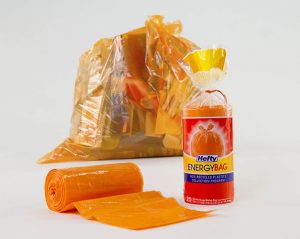 Anti-incineration activists are criticizing an industry program that diverts traditionally non-recycled plastics away from landfill and into energy-recovery facilities. In response, project backer Dow Chemical Co. has defended the program’s utility.
Anti-incineration activists are criticizing an industry program that diverts traditionally non-recycled plastics away from landfill and into energy-recovery facilities. In response, project backer Dow Chemical Co. has defended the program’s utility.
Using orange bags left at the curb, the Hefty EnergyBag program collects a range of plastic items, including multilayer bags and films, foam polystyrene goods and other packaging. The bags are then sent to a facility for energy recovery. For the past year, the program has collected plastic in Omaha, Neb. and sent it to a cement factory to be burned for energy.
Hefty EnergyBag is backed by DowDuPont subsidiary Dow Chemical Co., which teamed up with nonprofit group Keep America Beautiful (KAB) earlier this year to expand it to other municipalities. The program accepted grant applications from communities with access to a variety of energy-recovery technologies, including cement kilns and gasification and pyrolysis technologies. A Dow spokeswoman told Plastics Recycling Update the Hefty EnergyBag program has its roots in a 2014 pilot program in Citrus Heights, Calif., where material was collected for conversion into oil.
Dow wants to expand the program to all 50 states within the next five years.
‘Greenwashing’ stunt
Anti-incineration network GAIA recently issued a press release and webpage taking aim at Hefty EnergyBag, calling the program a “greenwashing” stunt.
“The program aims to collect throwaway plastic and packaging to burn and call it recycling,” according to GAIA’s online pledge. “Burning plastic is not recycling and emits toxic pollution that can harm communities. The EnergyBag program undermines real solutions – and we will not support it in our city.”
The online pledge has been signed by dozens of organizations around the country.
In GAIA’s press release, National Recycling Coalition (NRC) President Bob Gedert said NRC doesn’t consider the program “recycling.”
“The ‘energy recovery’ of the bags is not consistent with the definition of recycling and therefore is not a recycling program,” he stated.
GAIA’s campaign came after it issued a report calling waste-to-energy programs misguided attempts to achieve sustainability.
‘Complements mechanical recycling’
In a statement sent to Plastics Recycling Update, Dow noted that while recycling is the preferred solution for plastic waste, some plastics can’t readily be recycled.
“The Hefty EnergyBag program complements mechanical recycling by providing a much-needed solution for plastics that currently cannot be mechanically recycled, such as multilayer flexible film packaging,” the statement said. “The program enables curbside pick-up and conversion into valuable energy resources. This is a significant step forward in achieving positive long-term environmental and economic advantages, including more alternative energy resources and fewer tons of valuable plastics ending up in landfills.”
Dow noted the use in Europe of both mechanical recycling and energy recovery to minimize plastics going to landfill. The Hefty EnergyBag program can also help remove non-recycled materials from materials recovery facilities (MRFs), improving their efficiency.
Dow also said it’s “working to ensure that this program is accurately described as a plastics recovery initiative, which at this time is energy recovery.”


